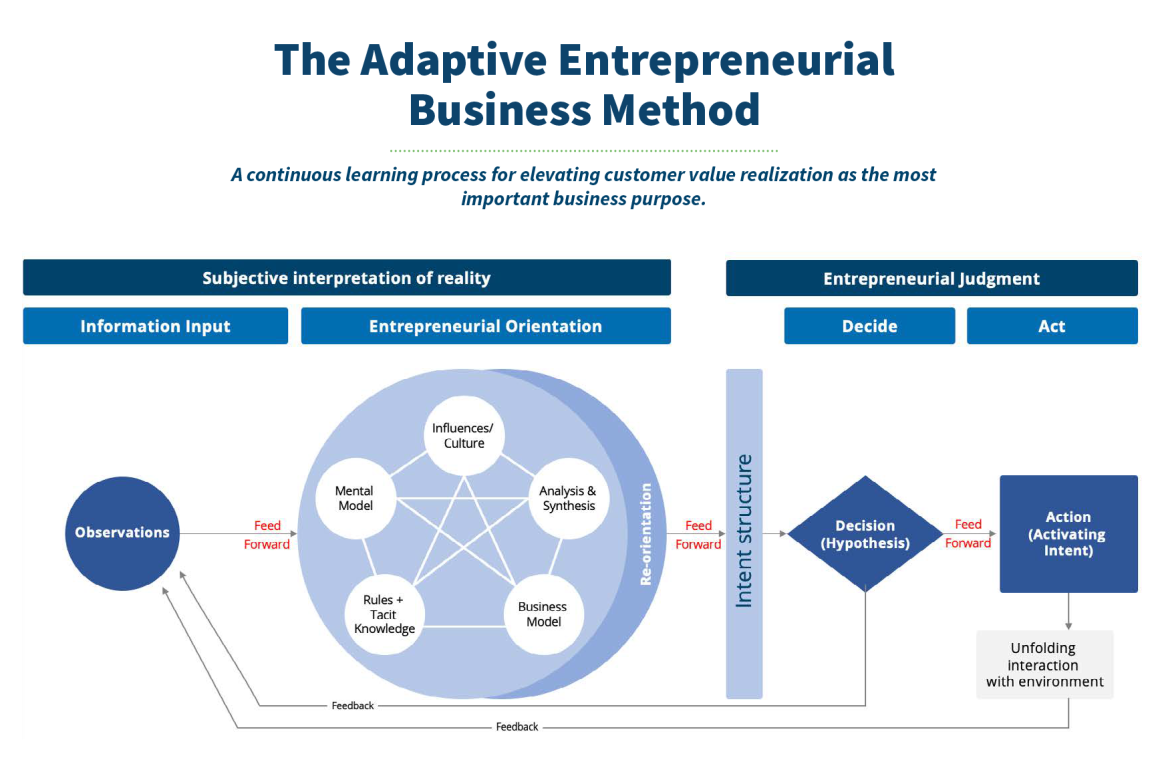
When firms apply the principles of Austrian economics to business management, we call the result the Adaptive Entrepreneurial Method. It’s adaptive in that it is a continuous learning process, and it’s entrepreneurial in elevating customer value realization as the most important business purpose.
Key Takeaways and Actionable Insights.
Businesses that follow the adaptive entrepreneurial method put customer value first.
Value in Austrian economics is customer value: contributing to customers’ feelings of being better off as a result of the interaction with an entrepreneurial business or service provider. A useful way to think about value is in terms of alignment and order. A value exchange is a harmonious alignment between customer and entrepreneur, in which both parties benefit and both parties’ interests are served. Order is represented by the customer’s decision, a point of clarity in a world of multiple choices, overlapping preferences and broad-based uncertainty.
Entrepreneurial businesses make value their purpose and identify it in alignment and harmony with customers. Everything else — cash flow, profits, growth — follows.
Entrepreneurial orientation enables the right interpretation of data and information for customer value realization.
Mark McGrath emphasizes the powerful role of entrepreneurial orientation in business success. Orientation is a mindset — a kind of internal operating system — that guides firms to translate information from customers, partners, competitors and the market into an effective, winning vision and mission.
The essence of orientation is learning. Uncertainty is assumed, and orientation is the unique set of filters through which entrepreneurs and management teams process the quantitative and qualitative data that customers and markets present. Mises called it economic calculation: the entrepreneurial capacity for combining a constantly changing stream of information into a business decision. The decisions are always reviewable and revisable; a learning mindset makes entrepreneurs comfortable with frequent decision changes in response to changing information and feedback. Principles — such as the primacy of customer value — remain the same; it’s actions that are adjusted.
Businesses that don’t learn can get locked into models that no longer reflect the realities of the marketplace, and lose their effectiveness.
People, ideas, and things.
Learning, adapting, and changing are difficult capabilities to master. Continuous change can feel disorienting absent the right mindset. How do companies achieve this mastery? Mark McGrath quotes Joh Boyd on the eternal verity of people, ideas, and things — always in that order.
The first critical component are the people engaged in and operating the business. They must be good at change, comfortable with constant flux. They must accept VUCA — volatility, uncertainty, complexity, and ambiguity — as the normal condition. At the same time, management must be conscious of how each new change or wave of change impacts people, and anticipates the effect it will have on them.
In this change-accepting environment, unlimited new ideas can emerge via the creative process. They can be tested, and marketplace results become the yardstick. When new ideas look promising in terms of the results they potentially enable, then things can be changed: capital can be redeployed in new combinations, marketing campaigns can be revised. When people are pre-prepared, smooth transitions are achievable.
Continuous Reorientation And Entrepreneurial Intent.
While entrepreneurial orientation is the firm’s operating system for processing information, it is not fixed. Adaptive firms are continuously reorienting, Active reorientation supports learning, recognizing that all perceptual models are only as good as the moment they were developed. They must be renewed to stay relevant. Challenging assumptions and reframing problems must be continuous in order for firms to thrive and use change to advantage. Effective orientation looks to the future rather than the present, emphasizing agility and avoiding clinging to outdated models.
Reorientation precedes intent and reshapes it. Entrepreneurial intent can be equated to what systems thinkers call vision. A vision is shared and provides a North Star for everyone in the firm, but that doesn’t preclude adjustment in continuous alignment with customers. The vision is to serve customers, and customers are also changing and adjusting. Thinking in terms of intent (rather than, say, implementing a rigid plan) permits greater flexibility in pursuit of the vision.
Entrepreneurial judgment is decision and action.
The theory of entrepreneurship emphasizes judgment — that mysterious-sounding capability of entrepreneurs to make economic calculations from a mix of data and intuition. That can sound like a kind of mulling over of options. But it’s much more active than that. The entrepreneurial method emphasizes deciding and acting. Decisions are recognized as hypotheses; it’s impossible to know exactly what to do, so action-oriented develop hypotheses about what actions could have the effect they desire. The hypotheses are carefully aligned with their intent in order to double-check the logic as far as possible. But the purpose is not to be “right” but to generate feedback information so that alignment can be better informed by reality.
Action — the implementation of decisions — is an experiment, a test of the hypothesis. Action produces interaction (with customers, with retailers, with competitors, with the changing market environment) and thereby provides new information in the form of feedback, which might indicate the need to change actions next time.
The number of hypotheses and tests can be narrowed; what’s important is that they reflect as wide a range of perspectives as possible — from those at the front line interacting with customers, whether in person or at the call center or online, from engineers and operatives, from finance and HR, and from all relevant points of view. The more diverse the range of perspectives, the more likely it is that different angles of view will provide new insights and illuminate blind spots. Make sure that internal communications are organized so as to make it possible for all perspectives — including dissenting Cassandras – to be recognized and acknowledged.
Candid self-assessment of people in business leadership roles is a good place to start the adaptive entrepreneurial journey.
Some elements of the adaptive entrepreneurial model require the discarding of standard ways of managing. For example, many businesses spend considerable time and effort developing plans that lock in budgets and resource allocations, and don’t make allowance for constant adjustment and change. It’s useful to take inventory of these practices and question whether they can be abandoned or reformed in pursuit of agility.
Additional Resources
The “Adaptive Entrepreneurial Method” Graphic (PDF): Mises.org/E4B_192_PDF1
“Destruction and Creation” by John Boyd (PDF): Mises.org/E4B_192_PDF2
Mark J. McGrath on LinkedIn: Mises.org/E4B_192_LinkedIn
“Orientation: Bridging The Gap In The Austrian Theory of Entrepreneurship” (AERC 2022) by Mark J. McGrath and Hunter Hastings (PDF): Mises.org/E4B_192_PDF3



